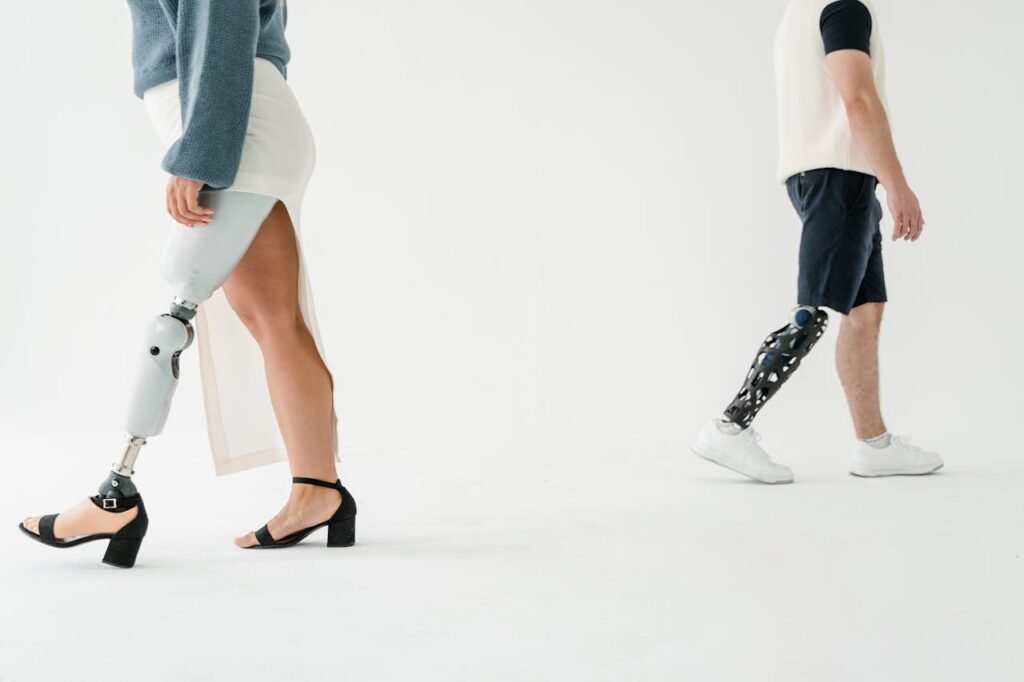A prosthetic limb is more than just a tool for mobility—it’s a vital partner in helping individuals achieve their professional goals and navigate the demands of the workplace. Whether you’re returning to a job after an amputation or seeking a prosthetic that enhances your work capabilities, finding the right fit is crucial. The choice of a prosthetic limb for work depends on factors like the nature of the job, the environment, and the physical requirements involved.
This guide will explore the key practical considerations when selecting a prosthetic limb for work, providing actionable insights to help users and businesses make informed decisions. From understanding job-specific needs to ensuring long-term comfort and durability, we’ll cover every aspect of this important choice.
Understanding Job-Specific Requirements
The first step in choosing a prosthetic limb for work is understanding the specific requirements of your job. Every profession has unique physical demands, and the prosthetic you select must align with the tasks you perform regularly.
Matching Features to Job Demands
A desk job might prioritize comfort and dexterity for tasks like typing, while a physically demanding role, such as construction or manual labor, may require a prosthetic that offers strength, durability, and stability. Similarly, professionals in creative fields, such as artists or musicians, may need specialized attachments or enhanced grip functionality.
For instance, a lower-limb prosthetic designed for outdoor work could include features like reinforced joints, shock-absorbing soles, or slip-resistant surfaces for added safety on uneven terrain.
An upper-limb prosthetic for a mechanic might include interchangeable tools or grips that make handling equipment easier and more efficient.
For businesses, offering a diverse range of prosthetic models tailored to various professions can cater to this broad spectrum of needs. Highlighting job-specific features during consultations ensures users can see how your products directly address their professional challenges.
Adapting to Work Environments
The environment in which you work also plays a significant role in determining the ideal prosthetic limb. Indoor workplaces often require a focus on precision and comfort, while outdoor or industrial settings may demand enhanced durability and adaptability.
For example, a prosthetic limb with weather-resistant materials and protective coatings might be essential for users working in harsh outdoor conditions. Alternatively, a lightweight and ergonomic design could be better suited for office environments where long hours of sitting or typing are common.
Businesses can enhance the selection process by offering environmental assessments as part of their services. Visiting a user’s workplace or reviewing their daily routines provides valuable insights into the conditions their prosthetic will need to withstand, leading to more accurate recommendations.
Diving Deeper Into Job Demands
A comprehensive analysis of job-specific demands requires looking beyond the obvious physical tasks and considering subtler factors, such as the frequency of repetitive movements, the need for precision, and the type of interactions the user has with tools or equipment.
For instance, a teacher who stands and writes on a whiteboard all day will need a prosthetic limb that supports prolonged standing and offers seamless movement for pointing or gesturing.
On the other hand, a warehouse worker who lifts heavy objects requires a prosthetic that delivers stability, weight distribution, and impact resistance.
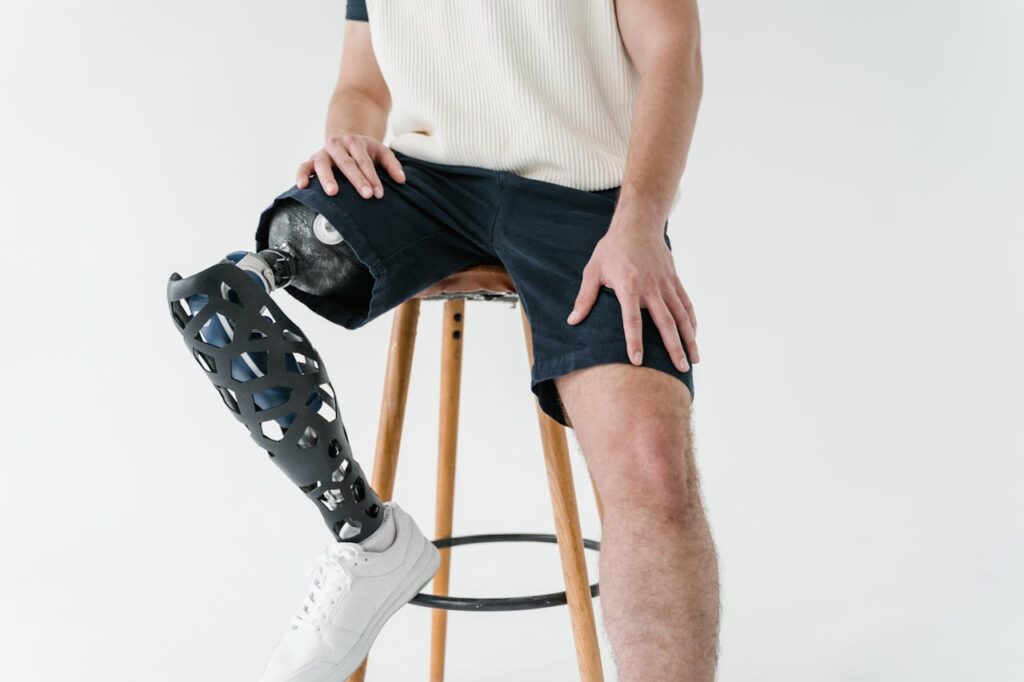
Businesses can enhance this understanding by conducting in-depth consultations with users and, where possible, visiting their workplaces. Observing tasks in real-world environments allows prosthetists to identify challenges users might not articulate, such as difficulty navigating tight spaces or uneven flooring.
These insights can then be used to recommend features and customizations that address specific pain points.
Bridging Functionality With Efficiency
A prosthetic limb designed for work must not only meet functional needs but also improve efficiency. For example, consider a graphic designer who requires an upper-limb prosthetic to operate a stylus or mouse.
While the primary focus might be on achieving dexterity, the prosthetic should also minimize fatigue during long hours of repetitive motion. This could be achieved by using lightweight materials and incorporating ergonomic grips that allow for smoother, more natural movements.
For businesses, offering modular solutions is a strategic way to bridge functionality and efficiency. A prosthetic limb with interchangeable attachments—such as specialized tools for typing, painting, or assembly—provides versatility and ensures the device remains relevant as job demands evolve.
Demonstrating these modular capabilities through workshops or product trials gives users confidence that their prosthetic is adaptable and future-ready.
Factoring in Work Environment
Work environments significantly influence the type of prosthetic that will deliver the best results. For instance, an individual working in a sterile healthcare environment will need a prosthetic limb made of materials that are easy to sanitize and resistant to corrosion from cleaning agents.
Meanwhile, someone working in an outdoor setting, such as landscaping or forestry, may prioritize features like waterproofing, dust resistance, and temperature durability.
For businesses, offering prosthetics tailored to environmental conditions involves a combination of material science and user education. Using durable, non-porous materials for wet or high-temperature environments can enhance the longevity and reliability of the prosthetic.
Additionally, providing users with detailed guidance on maintaining their prosthetic in different conditions ensures they get the most out of their device.
Addressing Physical Strength and Repetitive Motion
Jobs that require repetitive motions or significant physical strength pose unique challenges for prosthetic users. Repetitive tasks, such as typing, lifting, or operating machinery, can lead to wear on the prosthetic and physical fatigue for the user.
For those with lower-limb prosthetics, roles involving constant standing or walking demand exceptional stability and shock absorption.
Businesses must approach these challenges by incorporating biomechanics into the prosthetic design. For example, creating upper-limb prosthetics with controlled grip mechanisms can reduce strain during repetitive tasks like gripping tools.
Similarly, lower-limb prosthetics that mimic the natural gait cycle through energy-return technology provide comfort and reduce energy expenditure for jobs that require extensive movement.
Highlighting how these features reduce fatigue and improve performance in real-world applications strengthens the value proposition of your product.
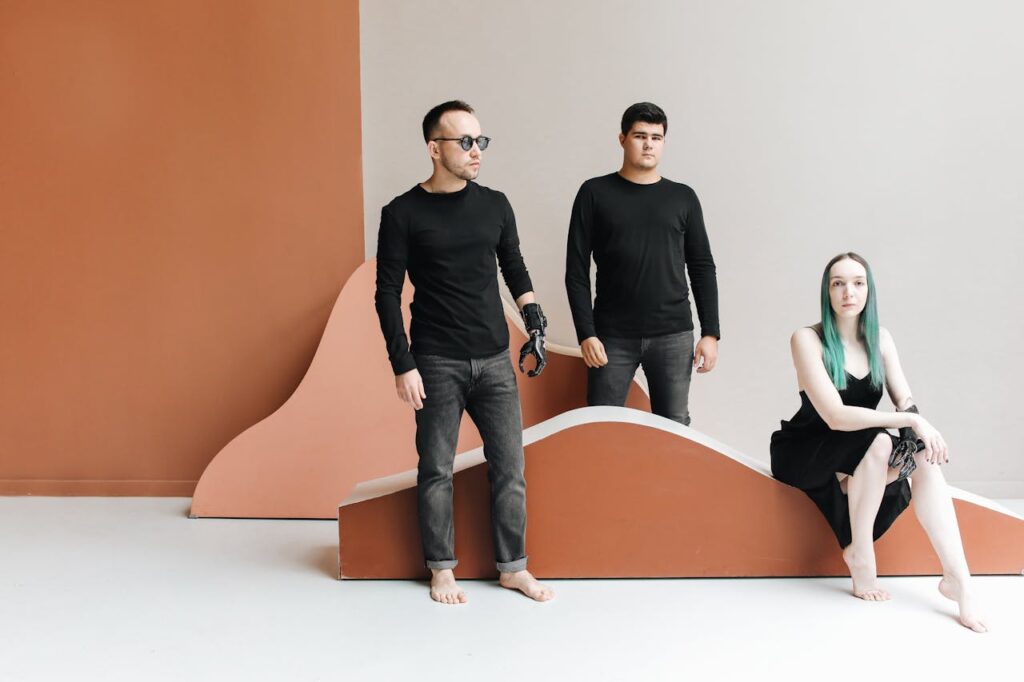
Ensuring Comfort and Fit for Long Work Hours
Comfort is a top priority for anyone using a prosthetic limb, but it becomes even more critical when you’re wearing it for extended periods at work. A prosthetic that causes discomfort or fatigue can negatively impact both productivity and overall well-being.
The Importance of a Perfect Fit
A well-fitted prosthetic limb reduces pressure points, prevents irritation, and ensures even weight distribution. This is particularly important for jobs that involve repetitive movements or prolonged standing, as poor fit can lead to pain or long-term issues like joint strain.
For businesses, investing in advanced fitting technologies like 3D scanning or digital modeling ensures precision during the fitting process. Offering trial periods or test sockets allows users to provide feedback and make adjustments before finalizing their prosthetic, ensuring optimal comfort.
Balancing Weight and Functionality
The weight of a prosthetic limb is another crucial consideration, especially for individuals performing physically demanding tasks. Lightweight materials like carbon fiber or titanium can reduce fatigue, but they must still provide the necessary strength and durability to handle workplace challenges.
For example, a lower-limb prosthetic for a healthcare worker who is constantly on their feet should strike the right balance between being lightweight for comfort and robust enough to provide stability.
Businesses can emphasize the benefits of these materials during consultations, explaining how they enhance both functionality and usability.
Prioritizing Durability and Reliability
For individuals relying on prosthetic limbs at work, durability and reliability are non-negotiable. A prosthetic must perform consistently under the physical demands of the job while maintaining its integrity over time. This is especially true for professions where the prosthetic is exposed to heavy use, harsh conditions, or repetitive tasks.
Designing for Physical Demands
Jobs that require heavy lifting, repetitive motion, or exposure to extreme environments demand prosthetics built with robust materials and reinforced components.
For example, a laborer working in construction might need a prosthetic limb with high-impact resistance, reinforced joints, and anti-corrosion features to handle dust, moisture, and intense activity.
For businesses, highlighting these rugged designs and their testing standards reassures users of the prosthetic’s capability to withstand their work environment. Real-world demonstrations or testimonials from users in similar roles can further build confidence in the product’s reliability.
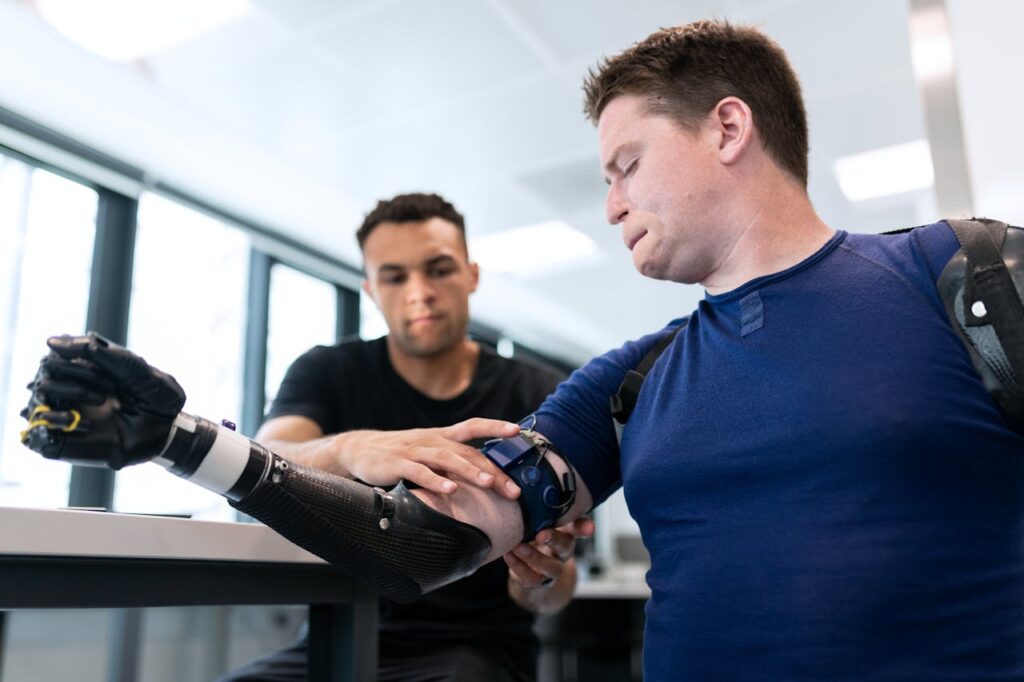
Minimizing Downtime
Downtime caused by prosthetic repairs or malfunctions can disrupt a user’s professional life, especially in roles with tight schedules or critical responsibilities. To minimize this, prosthetics for work must include features that simplify maintenance and increase reliability.
For instance, modular designs allow users to replace worn-out components quickly without requiring extensive repairs. Providing users with easy access to spare parts or a responsive service team ensures they can address issues promptly and get back to work with minimal delays.
Businesses offering maintenance plans or warranties tailored to workplace use can differentiate themselves by demonstrating a proactive commitment to user satisfaction.
Enhancing Productivity Through Advanced Features
Modern prosthetics go beyond basic functionality, incorporating advanced features that enhance productivity and adaptability in the workplace. These innovations allow users to work more efficiently and confidently, even in challenging conditions.
Integrating Smart Technologies
Prosthetics equipped with smart technologies, such as sensors and microprocessors, provide real-time feedback and adaptive control.
For example, a lower-limb prosthetic with a microprocessor knee can adjust resistance based on terrain or movement speed, allowing a factory worker to transition seamlessly between tasks that require walking, climbing, or lifting.
For upper-limb prosthetics, advanced myoelectric models that respond to muscle signals enable precise movements, making them ideal for jobs requiring fine motor skills, such as assembling electronics or working as a craftsman.
Businesses that integrate these smart features into their prosthetics should provide training and demonstrations to help users understand and maximize these capabilities. Customization options, such as preset modes for specific tasks, can further enhance usability and appeal to professionals seeking efficiency.
Custom Attachments for Specialized Tasks
Some professions require tools or attachments that standard prosthetics may not accommodate. Custom attachments—such as specialized grips, hooks, or adapters—enable users to perform job-specific tasks with ease.
For example, a chef might benefit from a prosthetic attachment designed to hold utensils securely, while a technician could use an attachment optimized for handling small tools.
Businesses that offer customization services for these attachments position themselves as problem-solvers, addressing unique challenges faced by working professionals.
Supporting Workplace Adaptation
Adapting to a prosthetic limb in the workplace involves more than just physical adjustments; it also requires navigating social dynamics and logistical challenges. Businesses that provide holistic support for workplace adaptation create a more inclusive and empowering experience for users.
Building Confidence Through Training
Using a prosthetic limb effectively in a professional setting often requires practice and confidence. Businesses can support this process by offering tailored training programs that simulate workplace tasks and environments.
For instance, a training program for office workers could focus on typing techniques and desk ergonomics, while a program for field workers might address balance, lifting techniques, or using adaptive tools.
Providing resources like instructional videos or one-on-one coaching helps users feel prepared to handle their responsibilities seamlessly.
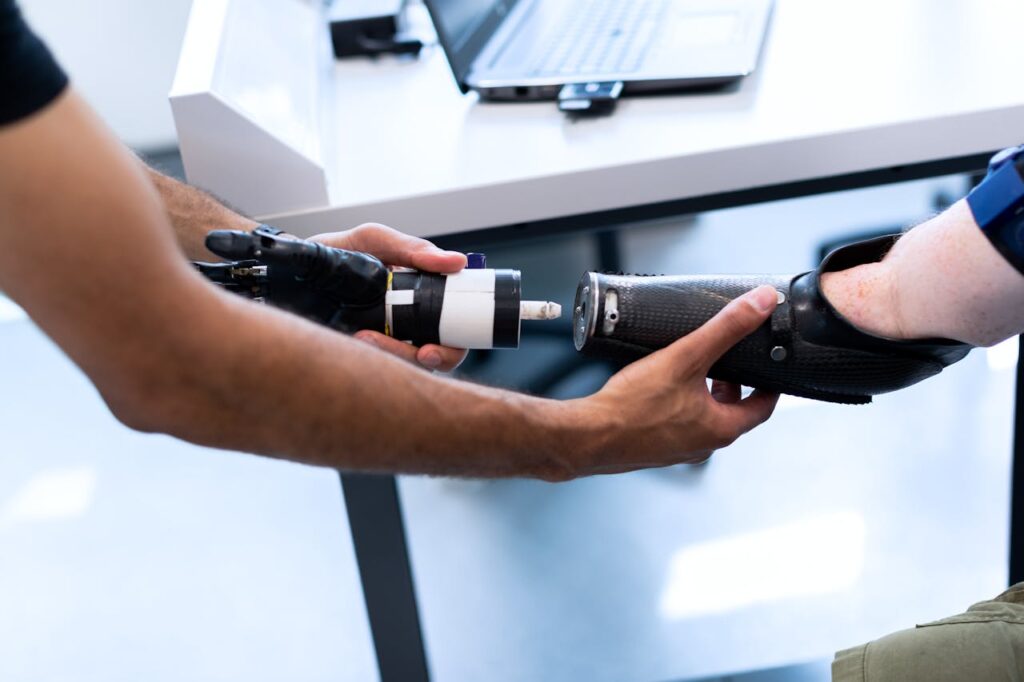
Promoting Workplace Inclusivity
Returning to work with a prosthetic limb can raise concerns about acceptance or understanding among colleagues. Businesses can assist users by offering educational materials or workshops for employers and coworkers, fostering a more inclusive workplace environment.
These initiatives could include demonstrations of how prosthetics function, discussions about the challenges users face, and strategies for creating supportive work environments.
By facilitating open conversations, businesses help users feel valued and included, reducing potential anxieties about workplace integration.
Addressing Long-Term Adaptation and Growth
A prosthetic limb is not just a tool for immediate use; it must grow with the user, adapting to their evolving professional and personal needs. Long-term adaptation involves ensuring the prosthetic remains functional, comfortable, and relevant as users progress in their careers and encounter new challenges.
Planning for Professional Growth
As users advance in their careers, their roles and responsibilities may change, requiring new capabilities from their prosthetic limb. For example, a promotion to a managerial position might reduce the need for heavy physical activity and increase the demand for fine motor skills or presentational comfort. Alternatively, a transition to a more active role may require greater durability or enhanced features.
For businesses, offering upgradeable or modular prosthetics allows users to adapt their device to new job requirements without replacing the entire limb.
For instance, an upper-limb prosthetic with interchangeable attachments can transition from basic tasks to specialized functions, such as handling precise instruments or tools. Highlighting these options during the initial consultation helps users understand the long-term value of their prosthetic.
Providing Continuous Support
Long-term success with a prosthetic limb in the workplace requires ongoing support from both the provider and the user’s professional network.
Regular check-ups with prosthetists ensure that the device remains well-fitted and functional, addressing any discomfort or wear-and-tear issues before they impact productivity.
Businesses can enhance this process by offering maintenance packages that include periodic adjustments, replacement parts, and troubleshooting services.
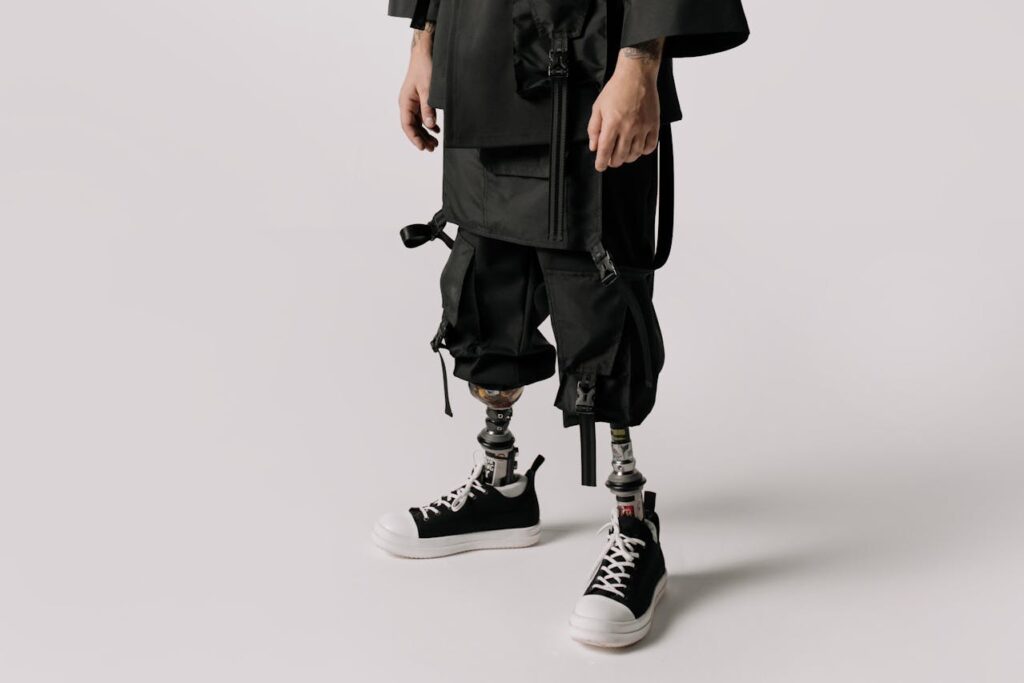
Digital platforms that enable users to schedule appointments, order components, or access instructional content add convenience and foster a sense of reliability.
Additionally, establishing mentorship programs where experienced prosthetic users share tips and insights with new users can provide practical advice and emotional encouragement. For businesses, facilitating these connections strengthens their role as a trusted partner in the user’s journey.
Designing for Emotional Well-Being and Workplace Confidence
The transition to using a prosthetic limb at work is as much an emotional adjustment as it is a physical one. Feelings of self-consciousness, uncertainty, or apprehension can affect how users perceive themselves and interact with others in the workplace. Addressing these concerns through thoughtful design and proactive support helps users feel empowered and confident.
Aesthetics and Personalization
The appearance of a prosthetic limb can significantly influence how users feel about wearing it in professional settings. Prosthetics that blend seamlessly with the user’s natural appearance or feature personalized designs help boost self-esteem and reduce feelings of self-consciousness.
For businesses, offering aesthetic options—such as skin-toned finishes, sleek modern designs, or even artistic customizations—demonstrates an understanding of the emotional aspects of prosthetic use. Consulting with users about their preferences and offering tailored solutions creates a sense of ownership and pride in their device.
Building Resilience Through Success Stories
Sharing success stories of other professionals who have excelled with prosthetic limbs can inspire new users and show them what’s possible. These stories serve as powerful reminders that prosthetics are enablers of potential, not limitations.
Businesses can create content—such as blogs, videos, or interviews—that highlights the achievements of prosthetic users in various industries. These narratives not only motivate individuals but also educate employers and coworkers about the capabilities of prosthetic technology, fostering inclusivity and respect.
Innovating for Future Workplace Needs
The nature of work is constantly evolving, and so are the demands placed on prosthetic limbs. Advancements in technology and design are opening new possibilities for creating devices that align with future workplace trends. Businesses that anticipate these changes and invest in innovation can offer products that remain relevant and competitive.
The Role of AI and Smart Systems
Artificial intelligence (AI) and smart systems are transforming the way prosthetics interact with users and their environments. For workplace applications, AI-driven prosthetics can optimize performance by learning from user behavior and adjusting in real time.
For example, a smart lower-limb prosthetic might adapt its resistance based on whether the user is walking, running, or climbing stairs, reducing effort and improving efficiency.
Similarly, upper-limb prosthetics equipped with machine learning algorithms could refine grip strength or movement precision based on repetitive tasks.
For businesses, incorporating these technologies into their products and offering training on their use ensures users can take full advantage of their capabilities.
Highlighting the practical workplace benefits of AI-driven prosthetics, such as increased productivity or reduced fatigue, positions your brand as a leader in innovation.

Sustainability and Ethical Manufacturing
Sustainability is becoming an increasingly important consideration in prosthetic manufacturing, particularly for environmentally conscious users and organizations. Developing prosthetics with recyclable components, using eco-friendly materials, and minimizing waste during production demonstrate a commitment to ethical practices.
Businesses can leverage these efforts as part of their value proposition, appealing to users and employers who prioritize sustainability. Marketing campaigns that highlight environmentally responsible initiatives reinforce your brand’s dedication to both innovation and social responsibility.
Conclusion
Choosing a prosthetic limb for work is a deeply personal and strategic decision. It’s about finding a device that not only meets the physical demands of the job but also empowers the user to thrive in their professional environment. From understanding job-specific requirements to prioritizing comfort, durability, and long-term adaptability, every aspect of the selection process matters.
For businesses, serving this audience is an opportunity to make a meaningful impact. By offering user-centric solutions, fostering inclusivity, and embracing innovation, companies can position themselves as trusted partners in the journey to workplace success.
Ultimately, a prosthetic limb designed with work in mind is more than a tool—it’s a gateway to independence, achievement, and growth. By choosing the right prosthetic and providing the necessary support, users and businesses together can redefine what’s possible in the modern workplace.



